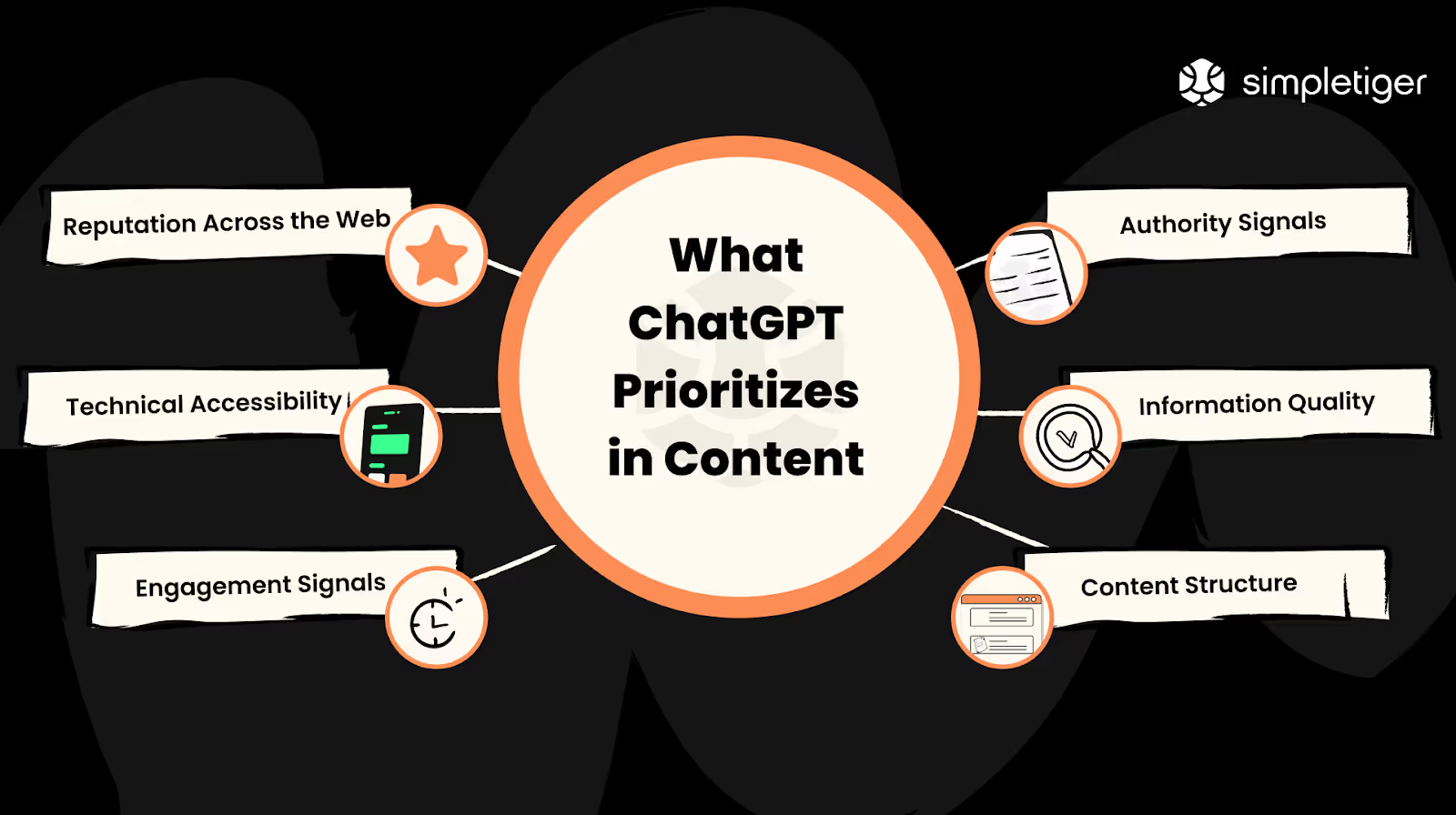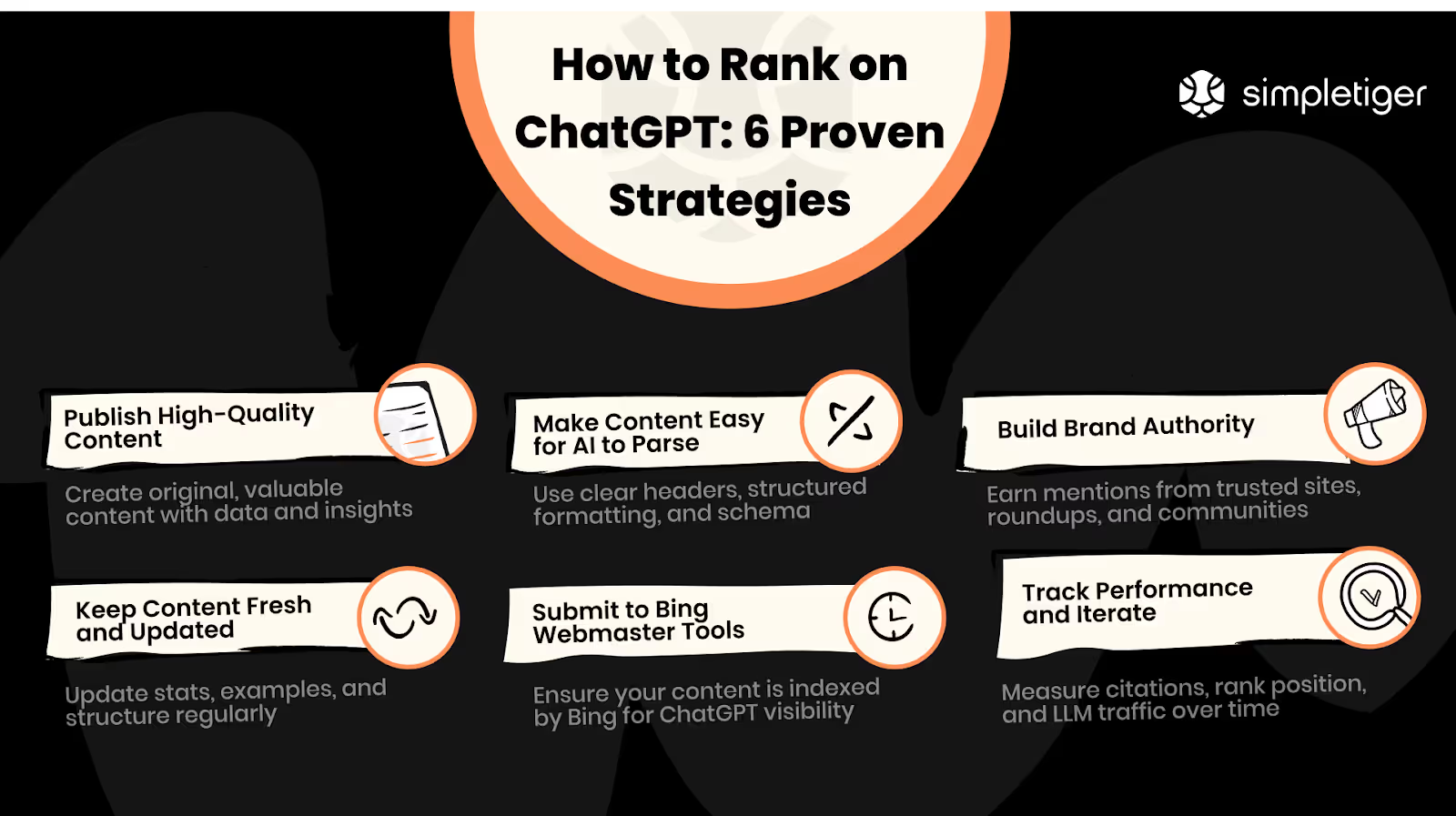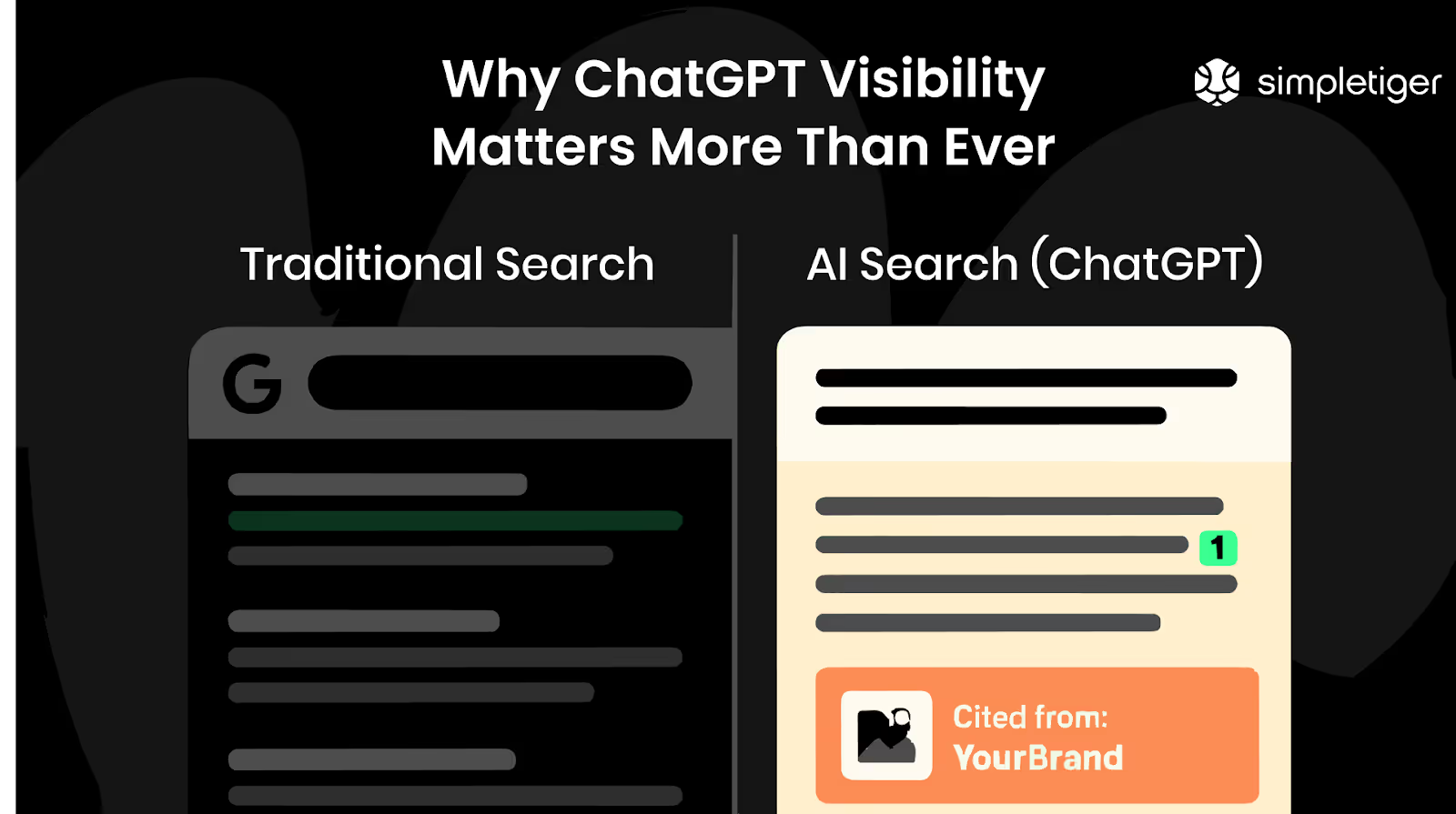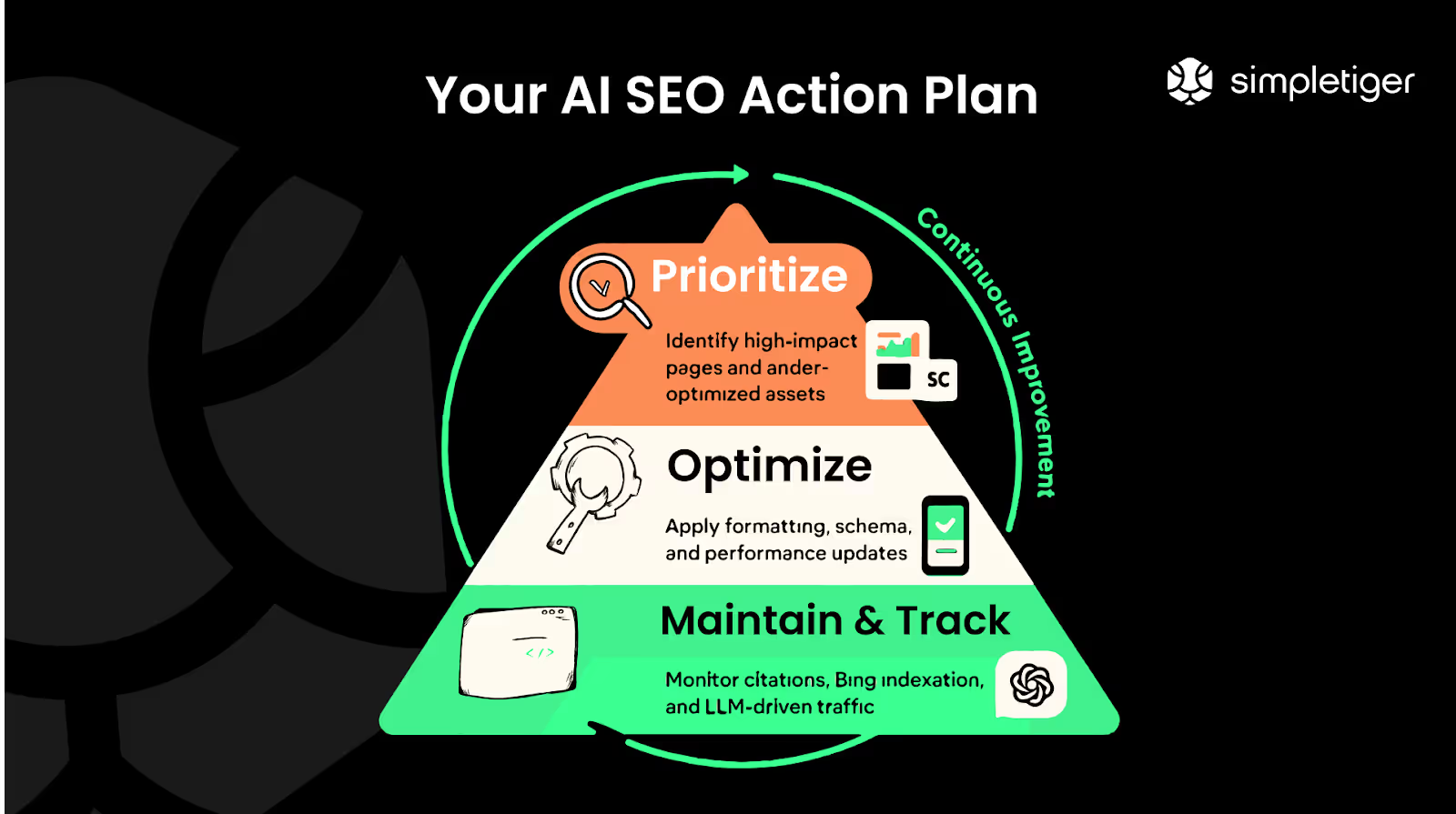Download the SaaS SEO Guide PDF
Over 60+ page SaaS SEO Guide in PDF format so you can read it whenever you want!



Over 60+ page SaaS SEO Guide in PDF format so you can read it whenever you want!







When ChatGPT hit 1 million users in just five days, it became clear that how people search, and how AI surfaces content, was changing fast. I’ve spent the years since digging into what actually earns visibility in ChatGPT’s responses.
What I’ve learned is that showing up in ChatGPT isn’t about shortcuts or hacks. It’s about applying SEO fundamentals in a way that makes your content easier for AI to understand, trust, and reference.
It builds on what already works in search, but with a few key adjustments. Ranking in AI-powered results rewards marketers who are thoughtful about how their content is structured, how clearly it answers real questions, and how well it aligns with user intent.
In this guide, I’ll walk you through the strategies that consistently get content referenced by ChatGPT, especially for SaaS SEO teams looking to stand out in an AI-driven search landscape.

ChatGPT doesn’t use rankings the way traditional search engines do. It’s not scanning page one or counting backlinks. Instead, it generates responses based on what it has learned during training and, when browsing is enabled, what it can access in real time through Bing.
When ChatGPT cites a source, it is usually because the content is easy to understand, factually accurate, and written with authority. The more your content aligns with these signals, the more likely it is to be referenced in AI-generated answers.
Here are a few things that influence what ChatGPT includes:
While Google ranks pages to display in search results, ChatGPT, which now receives approximately 5.24 billion visits per month, creates original responses using citations from sources it deems authoritative. Your content needs to be citation-worthy, not just keyword-optimized.

The following strategies are based on real-world results across industries and search environments. They focus on what ChatGPT actually cites: fact-based, clearly structured, and widely trusted content, and what you can do to ensure your content stands out as a source the AI recognizes and reuses.
To earn a spot in ChatGPT’s responses, your content must offer original value, not just rephrased best practices. The AI prefers content that offers something unique: data, expertise, or insight that can’t be found elsewhere.
This means prioritizing:
Reverse engineer user intent to understand exactly what your audience is looking for and shape your content to meet those needs, whether they're seeking to learn, compare options, or make a purchase decision.
Avoid shallow content or recycled ideas. If your content offers clear evidence and novel insights, it becomes citation-worthy, boosting your likelihood of being referenced when ChatGPT answers related queries.
Even the most insightful content won’t be cited if AI systems can’t read or understand it. That’s why optimizing structure and technical performance is critical.
To improve readability and extractability:
From a technical standpoint:
You can also enhance engagement with interactive elements like polls, charts, calculators, or short videos. These features increase dwell time and signal content value to AI systems.
ChatGPT doesn’t just evaluate content in isolation. It considers who it’s coming from. Authority matters. If respected sources consistently mention your brand, it gains credibility in AI models.
Focus on two major levers:
You can also boost perceived trust by encouraging third-party validation:
AI tools like ChatGPT favor content that reflects current realities. If your content is stale, outdated, or filled with broken links, it’s unlikely to rank or be cited.
Timeliness signals relevance. And relevance drives visibility in generative AI tools.
To keep content fresh:
Also, stay attuned to how people search:
Because ChatGPT uses Bing as its source for current web data, ensuring that your content is properly indexed by Bing is a fundamental step in AI visibility.
Start by setting up and verifying your site on Bing Webmaster Tools. Then:
Even if your Google rankings are strong, neglecting Bing means missing out on AI-driven exposure. We’ve seen many clients dramatically improve their ChatGPT citations simply by ensuring their pages are visible and crawlable by Bing.
Improving visibility in ChatGPT requires ongoing measurement, not guesswork. Establish benchmarks now to stay competitive as AI search evolves.
I track ChatGPT performance through several key methods:
When evaluating performance, focus on these key metrics:
As large language models become more deeply integrated into search experiences, building a performance tracking system now will help you adapt quickly and maintain a strategic edge.

ChatGPT is quickly becoming a primary way people consume content, make decisions, and discover brands. With over 5 billion visits per month and integrations into tools like Microsoft Copilot and Bing Chat, it’s evolving into an AI layer that sits between your content and your customer.
When your content is cited in ChatGPT responses, you're no longer fighting for clicks among 10 blue links. You're embedded directly into the answer, framed as a trusted source in real time.
This matters because:
Brands that show up in ChatGPT today are building awareness and authority in a space that’s still under-optimized. Those who wait risk losing ground to faster-moving competitors already embedding themselves in the AI-powered discovery journey.

To summarize the six key strategies for ranking on ChatGPT:
Implementing these strategies doesn't require a complete overhaul, but it does require thoughtful prioritization and consistent execution. Start by identifying low-effort, high-impact opportunities. Which existing blog posts get the most traffic? Which assets already rank in Bing or include partial schema but need optimization?
Build your process around incremental improvements. For example:
Set time aside monthly to check whether you’re being cited in ChatGPT queries. If not, review the structure and authority of your top pages. Look for patterns in what's working and what's not and use those insights to guide your next batch of updates.
Note that these optimizations don’t just improve performance in ChatGPT, they also strengthen your visibility across other AI-driven search tools like Perplexity, Claude, and Copilot, which draw on similar technical and contextual cues.
AI search is evolving fast, but small, well-targeted improvements can compound quickly. By staying focused and intentional, you'll build sustainable visibility where it matters most.
At SimpleTiger, we help SaaS companies show up where their buyers are asking questions. Our Generative Engine Optimization service is built to extend your existing SEO strategy, not replace it. We take the foundations that already work in search and apply them in ways that help your content surface in tools like ChatGPT, Perplexity, Bing Chat, and Google SGE.
GEO is focused, fast, and built for growth. Using proprietary AI technology, we identify high-impact opportunities, track real visibility across AI platforms, and structure your content so it is easy for both people and AI to find, understand, and trust.
If your goal is to stay visible as search evolves, this is how you get there.
Want to see how your content performs in AI search? Book a Discovery Call.

Sean is Chief Operating Officer at SimpleTiger, responsible for operations, process creation, team utilization and growth, as well as sometimes direct client consultation.
Over 60+ pages detailing how to grow your SaaS company using a proven SEO process.


Schedule a Discovery Call and see how we've helped hundreds of SaaS companies grow!




Actionable insights to help you grow your SaaS and dominate your search market!